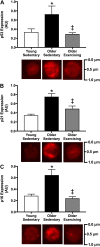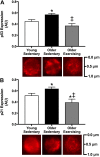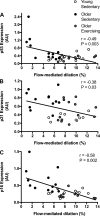Endothelial cell senescence with aging in healthy humans: prevention by habitual exercise and relation to vascular endothelial function
- PMID: 28971843
- PMCID: PMC5792201
- DOI: 10.1152/ajpheart.00416.2017
Endothelial cell senescence with aging in healthy humans: prevention by habitual exercise and relation to vascular endothelial function
Abstract
Cellular senescence is emerging as a key mechanism of age-related vascular endothelial dysfunction, but evidence in healthy humans is lacking. Moreover, the influence of lifestyle factors such as habitual exercise on endothelial cell (EC) senescence is unknown. We tested the hypothesis that EC senescence increases with sedentary, but not physically active, aging and is associated with vascular endothelial dysfunction. Protein expression (quantitative immunofluorescence) of p53, a transcription factor related to increased cellular senescence, and the cyclin-dependent kinase inhibitors p21 and p16 were 116%, 119%, and 128% greater (all P < 0.05), respectively, in ECs obtained from antecubital veins of older sedentary (60 ± 1 yr, n = 12) versus young sedentary (22 ± 1 yr, n = 9) adults. These age-related differences were not present (all P > 0.05) in venous ECs from older exercising adults (57 ± 1 yr, n = 13). Furthermore, venous EC protein levels of p53 (r = -0.49, P = 0.003), p21 (r = -0.38, P = 0.03), and p16 (r = -0.58, P = 0.002) were inversely associated with vascular endothelial function (brachial artery flow-mediated dilation). Similarly, protein expression of p53 and p21 was 26% and 23% higher (both P < 0.05), respectively, in ECs sampled from brachial arteries of healthy older sedentary (63 ± 1 yr, n = 18) versus young sedentary (25 ± 1 yr, n = 9) adults; age-related changes in arterial EC p53 and p21 expression were not observed (P > 0.05) in older habitually exercising adults (59 ± 1 yr, n = 14). These data indicate that EC senescence is associated with sedentary aging and is linked to endothelial dysfunction. Moreover, these data suggest that prevention of EC senescence may be one mechanism by which aerobic exercise protects against endothelial dysfunction with age.NEW & NOTEWORTHY Our study provides novel evidence in humans of increased endothelial cell senescence with sedentary aging, which is associated with impaired vascular endothelial function. Furthermore, our data suggest an absence of age-related increases in endothelial cell senescence in older exercising adults, which is linked with preserved vascular endothelial function.
Keywords: cardiovascular disease; cell cycle arrest; senescence-associated secretory phenotype.
Copyright © 2017 the American Physiological Society.
Figures



References
-
- Benjamin EJ, Blaha MJ, Chiuve SE, Cushman M, Das SR, Deo R, de Ferranti SD, Floyd J, Fornage M, Gillespie C, Isasi CR, Jiménez MC, Jordan LC, Judd SE, Lackland D, Lichtman JH, Lisabeth L, Liu S, Longenecker CT, Mackey RH, Matsushita K, Mozaffarian D, Mussolino ME, Nasir K, Neumar RW, Palaniappan L, Pandey DK, Thiagarajan RR, Reeves MJ, Ritchey M, Rodriguez CJ, Roth GA, Rosamond WD, Sasson C, Towfighi A, Tsao CW, Turner MB, Virani SS, Voeks JH, Willey JZ, Wilkins JT, Wu JH, Alger HM, Wong SS, Muntner P; American Heart Association Statistics Committee and Stroke Statistics Subcommittee . Heart Disease and Stroke Statistics-2017 update: a report from the American Heart Association. Circulation 135: e146–e603, 2017. doi:10.1161/CIR.0000000000000485. - DOI - PMC - PubMed
MeSH terms
Substances
Grants and funding
LinkOut - more resources
Full Text Sources
Other Literature Sources
Medical
Research Materials
Miscellaneous

